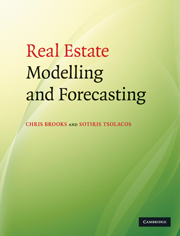Book contents
- Frontmatter
- Contents
- List of figures
- List of tables
- List of boxes
- Preface
- Acknowledgements
- 1 Introduction
- 2 Mathematical building blocks for real estate analysis
- 3 Statistical tools for real estate analysis
- 4 An overview of regression analysis
- 5 Further issues in regression analysis
- 6 Diagnostic testing
- 7 Applications of regression analysis
- 8 Time series models
- 9 Forecast evaluation
- 10 Multi-equation structural models
- 11 Vector autoregressive models
- 12 Cointegration in real estate markets
- 13 Real estate forecasting in practice
- 14 The way forward for real estate modelling and forecasting
- References
- Index
5 - Further issues in regression analysis
Published online by Cambridge University Press: 05 June 2012
- Frontmatter
- Contents
- List of figures
- List of tables
- List of boxes
- Preface
- Acknowledgements
- 1 Introduction
- 2 Mathematical building blocks for real estate analysis
- 3 Statistical tools for real estate analysis
- 4 An overview of regression analysis
- 5 Further issues in regression analysis
- 6 Diagnostic testing
- 7 Applications of regression analysis
- 8 Time series models
- 9 Forecast evaluation
- 10 Multi-equation structural models
- 11 Vector autoregressive models
- 12 Cointegration in real estate markets
- 13 Real estate forecasting in practice
- 14 The way forward for real estate modelling and forecasting
- References
- Index
Summary
Learning outcomes
In this chapter, you will learn how to
construct models with more than one explanatory variable;
derive the OLS parameter and standard error estimators in the multiple regression context;
determine how well the model fits the data;
understand the principles of nested and non-nested models;
test multiple hypotheses using an F-test;
form restricted regressions; and
test for omitted and redundant variables.
Generalising the simple model to multiple linear regression
Previously, a model of the following form has been used:
Equation (5.1) is a simple bivariate regression model. That is, changes in the dependent variable are explained by reference to changes in one single explanatory variable x. What if the real estate theory or the idea that is sought to be tested suggests that the dependent variable is influenced by more than one independent variable, however? For example, simple estimation and tests of the capital asset pricing model can be conducted using an equation of the form of (5.1), but arbitrage pricing theory does not presuppose that there is only a single factor affecting stock returns. So, to give one illustration, REIT excess returns might be purported to depend on their sensitivity to unexpected changes in
(1) inflation;
(2) the differences in returns on short-and long-dated bonds;
(3) the dividend yield; or
(4) default risks.
- Type
- Chapter
- Information
- Real Estate Modelling and Forecasting , pp. 108 - 134Publisher: Cambridge University PressPrint publication year: 2010



